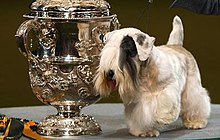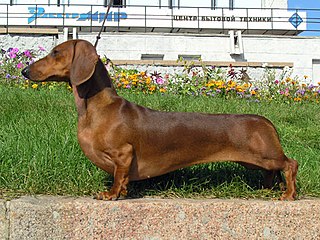
The dachshund, also known as the wiener dog or sausage dog, badger dog and doxie, is a short-legged, long-bodied, hound-type dog breed. The dog may be smooth-haired, wire-haired, or long-haired. Coloration varies.

The American Kennel Club (AKC) is a registry of purebred dog pedigrees in the United States. In addition to maintaining its pedigree registry, this kennel club also promotes and sanctions events for purebred dogs, including the Westminster Kennel Club Dog Show, an annual event which predates the official forming of the AKC, the National Dog Show and the AKC National Championship. The AKC is a non-member partner with the Fédération Cynologique Internationale. The AKC recognizes 200 dog breeds, as of 2022.

The Jack Russell Terrier is a British breed of small terrier. It is principally white-bodied and smooth-, rough- or broken-coated, and can be any colour.

The Chinese Crested Dog is a hairless breed of dog. Like most hairless dog breeds, the Chinese Crested Dog comes in two varieties, without hair and with hair, which can be born in the same litter: the hairless and the powderpuff.
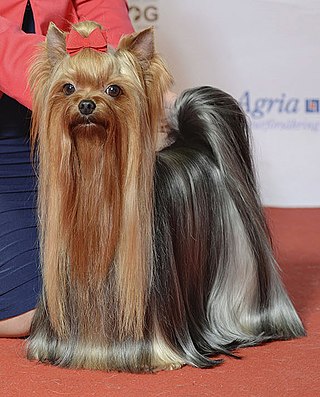
The Yorkshire Terrier, also known as a Yorkie, is a British breed of toy dog of terrier type. It is among the smallest of the terriers and indeed of all dog breeds, with a weight of no more than 3.2 kg (7 lb). It originated in the nineteenth century in the English county of Yorkshire, after which it is named. The coat is tan on the head and dark steel-grey on the body; no other colour is accepted by either The Kennel Club or the Fédération Cynologique Internationale.
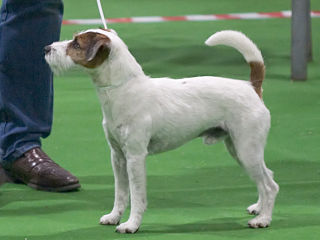
The Parson Russell Terrier is a breed of small white terrier that was the original Fox Terrier of the 18th century. The breed is named after the Reverend Jack Russell, credited with the creation of this type of dog. It is the recognised conformation show variety of the Jack Russell Terrier and was first recognised in 1990 in the United Kingdom as the Parson Jack Russell Terrier. In America, it was first recognised as the Jack Russell Terrier in 1997. The name was changed to its current form in 1999 in the UK and by 2008 all international kennel clubs recognised it under the new name.
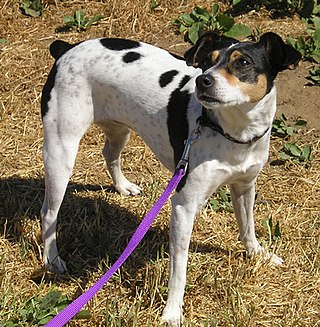
The Rat Terrier is an American dog breed with a background as a farm dog and hunting companion. They share much ancestry with the small hunting dogs known as feists. Common throughout family farms in the 1920s and 1930s, they are now recognized by the United (UKC) and American Kennel Clubs (AKC) and are considered a rare breed. Rat Terriers are an intelligent and active breed that can be kept both for pest control and as a family pet.
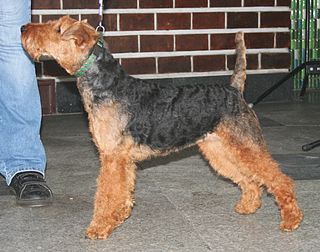
The Welsh Terrier originates from Wales and was originally bred for hunting fox, rodents and badger; but during the last century, it has mainly been bred for showing. Despite this, it has retained its terrier strength of character. The Welsh Terrier has been claimed to be the oldest existing dog breed in the UK.
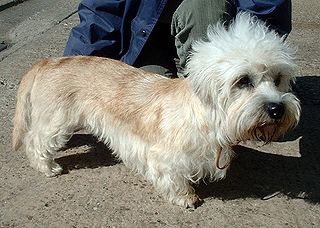
A Dandie Dinmont Terrier is a small Scottish dog breed in the terrier family. The breed has a very long body, short legs, and a distinctive topknot of hair on the head. They are friendly but tough, and are suitable for interaction with older children. There are breed-specific health concerns: they can be affected by spinal problems due to their elongated body, and the breed is affected by canine cancer at a higher than average rate.

The Kerry Blue Terrier is a breed of dog. Originally bred to control vermin including rats, rabbits, badgers, ferrets, foxes, otters, hares, deer, and even wolves, over time the Kerry became a general working dog used for a variety of jobs including herding cattle and sheep. Despite a Kerry Blue winning Crufts in 2000, it remains an "unfashionable" breed, and is distinctly uncommon; however, it is not as threatened as some of the other terrier breeds such as the Skye Terrier, Sealyham Terrier, and Dandie Dinmont Terrier.
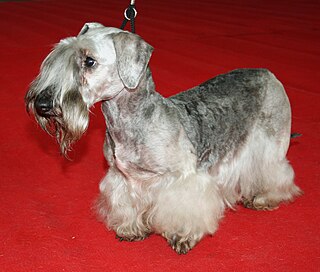
The Cesky Terrier is a small terrier type dog originating in Czechoslovakia.
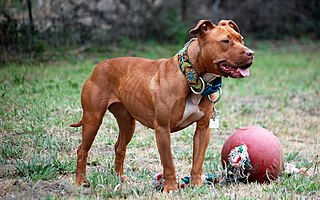
The American Pit Bull Terrier (APBT) is a dog breed recognized by the United Kennel Club (UKC) and the American Dog Breeders Association (ADBA), but not the American Kennel Club (AKC). It is a medium-sized, short-haired dog, of a solid build, whose early ancestors came from England. When compared with the English Staffordshire Bull Terrier, the American Pit Bull Terrier is larger by margins of 6–8 inches (15–20 cm) in height and 25–35 pounds (11–16 kg) in weight. The American Pit Bull Terrier varies in size: males are normally about 18–21 inches (45–53 cm) in height and around 35–60 pounds (15–27 kg) in weight, while females are normally around 17–20 inches (43–50 cm) in height and 30–50 pounds (13–22 kg) in weight.

The Teddy Roosevelt Terrier is a small to medium-sized American hunting terrier. It is lower-set, with shorter legs, and is more muscular with heavier bone density than the related American Rat Terrier. Much diversity exists in the history of the Teddy Roosevelt Terrier breed, and it shares a common early history with the American Rat Terrier, Fox Paulistinha, and Tenterfield Terrier. The Rat Terrier's background is said to stem from the terriers or other dogs that were brought over by early English and other working-class immigrants. Since the breed was a farm, hunting, and utility dog, little to no planned breeding was used other than breeding dogs with agreeable traits to each other to produce the desired work ethic in the dog. The Feist (dog), Bull Terrier, Smooth Fox Terrier, Manchester Terrier, Whippet, Italian Greyhound, the now extinct English White Terrier, Turnspit Dog, and Wry-legged Terrier all share in the Teddy Roosevelt Terrier's ancestry. These early ratting terriers were then most likely bred to the Beagle or Beagle crossbred dogs and other dogs. Maximizing the influences from these various breeds provides the modern Teddy Roosevelt Terrier with a keen sense of awareness and prey drive, an acute sense of smell, and a very high intellect. Although they tend to be aloof with strangers, they are devoted companion dogs with a strong desire to please and be near their owners at all times.
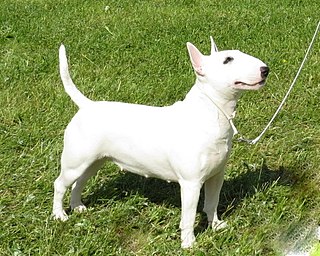
The English Miniature Bull Terrier is a breed with origins in the extinct English White Terrier, the Dalmatian and the Bulldog. The first existence is documented in 1872 in The Dogs of British Island.
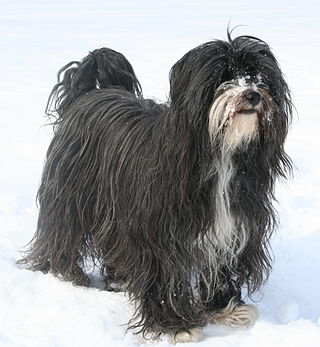
The Tibetan Terrier is a medium-sized breed of dog that originated in Tibet. Despite its name, it is not a member of the terrier group. The breed was given its English name by European travelers due to its resemblance to known terrier breeds. The Tibetan name for the breed, Tsang Apso, roughly translates to "shaggy or bearded ("apso") dog, from the province of Tsang". Some old travelers' accounts refer to the dog as Dokhi Apso or "outdoor" Apso, indicating a shaggy or bearded working dog which lives outdoors.

The Boykin Spaniel is a medium-sized breed of dog, a Spaniel bred for hunting wild turkeys and ducks in the Wateree River Swamp of South Carolina, in the United States. It is the state dog of South Carolina, where it was discovered and further developed by hunters in the early through mid 1900s. September 1 is Boykin Spaniel Day in South Carolina, originally established in 1984.

Vulnerable Native Breeds are a group of dog breeds originating in the United Kingdom and Ireland, and identified by The Kennel Club (KC) as having annual registration numbers of 300 puppies or fewer within the UK. The KC identified its need for such a list in June 2003, with research it conducted to identify the extent of the vulnerability and viability of each breed. It was a joint project, with the KC working with the British and Irish Native Breeds Trust, later to be known simply as the Native Dog Breeds Trust. The breeds on the list have been promoted at events such as Discover Dogs and Crufts, and by asking that owners of these breeds mate their dogs rather than having them spayed.

The Russian Toy is a very small breed of dog originally bred in Russia from the English Toy Terrier. There are two types of coats in the breed: smooth coat and long coat. The smooth-coated variety was previously known as the Russian Toy Terrier and long-coated as the Moscow Long-Haired Toy Terrier. Both were brought together under the same Russian Toy Terrier name in 1988 and the "Terrier" was dropped from the name when the breed was added in 2006 to the official list of breeds registered with the Fédération Cynologique Internationale and has been registered in the Foundation Stock Service of the American Kennel Club since 2008, allowed to compete in AKC companion events since 2010. The first official breed standard of the two varieties was written in 1966 in Russia.
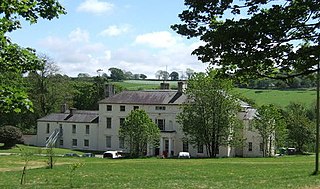
Sealyham Mansion, overlooking the little River Sealy, is a Georgian country house in Pembrokeshire, Wales, near Wolfscastle and to the southeast of Letterston. Known for the creation of the Sealyham Terrier there in the 1800s, the house served as a sanatorium and medical facility from 1923 to 1964. Since 1986 it has been a children's activity centre.

The Pumi is a medium-small breed of sheep dog from Hungary. They are capable herding dogs, able to gather and work close to farm stock, particularly sheep, to keep them under control. Pumik have an extended, tapered muzzle with prominent ears, and a tail curled over their back, and are sometimes described as having a whimsical expression. The double coat has a mix of wavy and curly hair.
